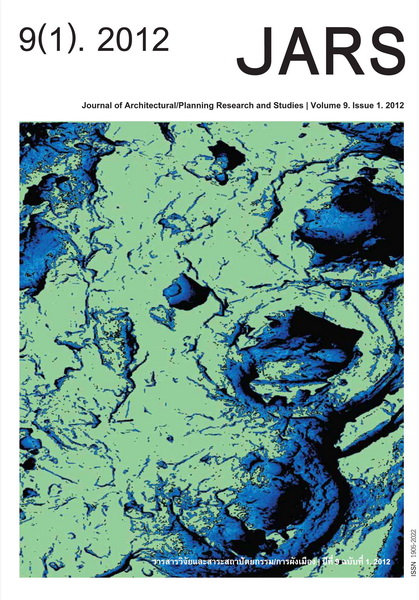Space as a Place for Social Interaction: A Case Study of Tai-Lao Communities
Main Article Content
Abstract
Regarding the social aspects of sustainable community design, the consideration of public space
should aim to support collaboration and social cohesion. As the Tai-Lao ethnic group in central Thailand have
been able to maintain their cultural identity and strong neighbourhood relationships, a lesson can be learned
from traditional communities about the adaptability of public space concerning social activities. This study
investigates the interrelationships between physical space and social interaction within Tai-Lao communities in
the central regions of Thailand and Luang Prabang, Laos, using qualitative field research. Adaptation to the
dominant culture and local development have brought changes to the physical features and utilization of
space, as well as changes in terms of its roles, values, and meanings which respond to different forms and
levels of social activity. Among a number of factors, social interaction is closely interconnected with the physical
settings of space, though the psychological meaning often plays a more important role. The interpretation of
adaptability in the physical structure of “Laan Klang Baan”, a public area within Lao Krang villages that still
maintains its meaning and spirit as a shared place, can be reconciled to maintain values of social contact and
to improve communal social cohesion by emphasizing a notion of place that represents psychological meaning
and belief.
Downloads
Article Details

This work is licensed under a Creative Commons Attribution-NonCommercial-NoDerivatives 4.0 International License.
All material is licensed under the terms of the Creative Commons Attribution 4.0 International (CC-BY-NC-ND 4.0) License, unless otherwise stated. As such, authors are free to share, copy, and redistribute the material in any medium or format. The authors must give appropriate credit, provide a link to the license, and indicate if changes were made. The authors may do so in any reasonable manner, but not in any way that suggests the licensor endorses you or your use. The authors may not use the material for commercial purposes. If the authors remix, transform, or build upon the material, they may not distribute the modified material, unless permission is obtained from JARS. Final, accepted versions of the paper may be posted on third party repositories, provided appropriate acknowledgement to the original source is clearly noted.
References
Chinat Cultural Office. (2011). Taam Ha Lao Krang Tee Kudjok. Chinat, Thailand: Chinat Cultural Office. Department of Environment, Transport and the Regions [DETR]. (2000). Planning Policy Guidance Note 3: Housing. London: Author.
Fleming, R., Baum, A., & Singer, J. E. (1985). Social support and the physical environment. In S. Cohen & S. L. Syme (Eds.), Social support and health. Orlando, FL.: Academic Press.
Gehl, J. (2001). Life between buildings: Using public space. Copenhagen, Arkitektens Forlag: The Danish Architectureal Press.
Inpuntung, V., Kasemsook, A., Panin, O., & Chaturawong, C. (2006). โลกของชาวไทดำ: ความสัมพันธ์ซึ่งกันระหว่างสภาพแวดล้อมที่อยู่อาศัยของชาวไทดำในไทยและเวียดนาม [Final Report of The world of Tai Dam: The relationship between living environments of Tai Dam in Thailand and Vietnam]. Bangkok, Thailand: Silpakorn University.
Khan, M. A. (1995). Sustainable development: The key concepts, issues and implications. Sustainable Development, 3, 63-69.
Lewis, S. (Ed.). (2005). Front to back: A design agenda for urban housing. Oxford: Architectural Press.
Panin, O., et al. (2010). First year progress report of holistic study for the adaptability in the different context of Tai-Lao ethnic in the central region basin of Thailand. Bangkok, Thailand: Kasetsart University, Thailand Research Fund and Office of the Higher Education Commission.
Pinibjvarasin, W. (2010). บริบทและการปรับตัวของชาวลาวเวียง [Context and Adaptability of Lao Vieng]. In Panin, O., et al. (Eds.). First year progress report of holistic study for the adaptability in the different context of Tai-Lao ethnic in the central region basin of Thailand. Bangkok, Thailand: Kasetsart University, Thailand Research Fund and Office of the Higher Education Commission.
Piyapan, B. (1998). ลาวในกรุงรัตนโกสินทร์ [Laotians in the Rattanakosin period]. Bangkok, Thailand: Thailand Research Fund.
Punpairoj, P. (2011). ไทดำรำพันถึงเรือนกระดองเต่า: จากขุนเขาเมืองแถงสู่ลุ่มน้ำภาคกลางของไทย [Tai Dam's longing for tortoise shaped houses: From the highlands of Muang Thaeng to the river basins of Thailand]. Journal of Architecture/Planning Research and Studies, 8(1), 21-34.
Thorns, D. C. (2004). Creating sustainable housing: The challenge of moving beyond environmentalism to new models of social development. Social Science Research Centre, University of Canterbury, New Zealand.

